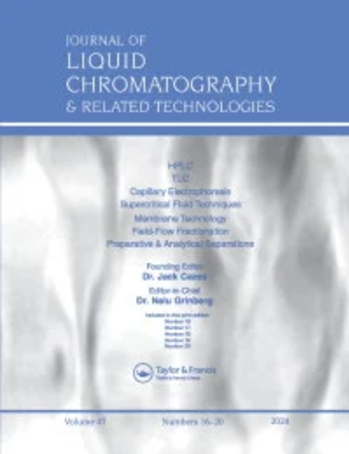从蓝莓中提取抗氧化剂
IF 1.2
4区 化学
Q4 BIOCHEMICAL RESEARCH METHODS
Journal of Liquid Chromatography & Related Technologies
Pub Date : 2023-07-03
DOI:10.1080/10826076.2023.2240913
引用次数: 1
摘要
摘要蓝莓因其风味、复杂的抗氧化剂和其他有益的植物化学物质而被广泛食用。蓝莓研究的核心是提取抗氧化剂的能力。为了进行适当的分析,提取的化合物必须代表蓝莓中所含的化合物,而不会产生偏差或信息丢失。考虑到目前存在的一系列复杂的植物化学物质,从蓝莓中提取这些化学物质是一项复杂的任务,也是当前文献中争论的焦点。虽然许多研究已经检查了最大限度地提高提取抗氧化剂浓度的最佳提取技术,但还没有系统研究提取条件和技术对从蓝莓样品中提取的抗氧化剂种类的影响。目前的研究通过应用高效液相色谱法结合新型柱后衍生化和常用的CURAC测定法来检测提取的抗氧化剂的范围和浓度,填补了这一空白。我们发现,溶剂的选择在决定提取的化合物的种类方面起着重要作用,酸化、提取时间和温度的影响最小,丙酮已被证明可以提供最大范围和最高浓度的化合物提取。图形摘要本文章由计算机程序翻译,如有差异,请以英文原文为准。
Extracting antioxidants from blueberries
Abstract Blueberries are widely consumed for their flavor and complex array of antioxidants and other beneficial phytochemicals. Central to studies on blueberries is the ability to extract antioxidants. For appropriate analysis, the extracted compounds must represent those contained in the blueberry without bias or loss of information. Given the complex array of phytochemicals present, extracting these chemicals from blueberries is a complex task and is the focus of much debate in the current literature. While many studies have examined the best extraction technique to maximize the concentration of extracted antioxidants, there remains no systematic study on the effect of extraction conditions and technique on the variety of antioxidants extracted from the blueberry samples. The current study fills this gap by applying High-Performance Liquid Chromatography combined with novel forms of post-column derivatization and the commonly used CUPRAC assay to examine the range and concentration of antioxidants extracted. We have found that solvent choice plays a large role in determining the variety of compounds extracted, with acidification, extraction time, and temperature having minimal effect, and acetone has been shown to provide extraction of the greatest range and highest concentration of compounds. Graphical Abstract
求助全文
通过发布文献求助,成功后即可免费获取论文全文。
去求助
来源期刊
CiteScore
2.80
自引率
0.00%
发文量
29
审稿时长
4.9 months
期刊介绍:
The Journal of Liquid Chromatography & Related Technologies is an internationally acclaimed forum for fast publication of critical, peer reviewed manuscripts dealing with analytical, preparative and process scale liquid chromatography and all of its related technologies, including TLC, capillary electrophoresis, capillary electrochromatography, supercritical fluid chromatography and extraction, field-flow technologies, affinity, and much more. New separation methodologies are added when they are developed. Papers dealing with research and development results, as well as critical reviews of important technologies, are published in the Journal.

 求助内容:
求助内容: 应助结果提醒方式:
应助结果提醒方式:


